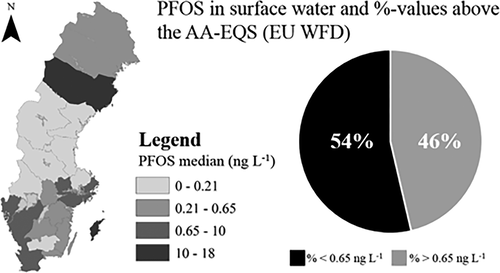当前位置:
X-MOL 学术
›
Environ. Sci. Technol.
›
论文详情
Our official English website, www.x-mol.net, welcomes your feedback! (Note: you will need to create a separate account there.)
Per- and Polyfluoroalkyl Substances in Swedish Groundwater and Surface Water: Implications for Environmental Quality Standards and Drinking Water Guidelines
Environmental Science & Technology ( IF 11.4 ) Pub Date : 2018-03-15 00:00:00 , DOI: 10.1021/acs.est.7b05718 Laura Gobelius 1 , Johanna Hedlund 1 , Wiebke Dürig 1 , Rikard Tröger 1 , Karl Lilja 2 , Karin Wiberg 1 , Lutz Ahrens 1
Environmental Science & Technology ( IF 11.4 ) Pub Date : 2018-03-15 00:00:00 , DOI: 10.1021/acs.est.7b05718 Laura Gobelius 1 , Johanna Hedlund 1 , Wiebke Dürig 1 , Rikard Tröger 1 , Karl Lilja 2 , Karin Wiberg 1 , Lutz Ahrens 1
Affiliation

|
The aim of this study was to assess per- and polyfluoroalkyl substances (PFASs) in the Swedish aquatic environment, identify emission sources, and compare measured concentrations with environmental quality standards (EQS) and (drinking) water guideline values. In total, 493 samples were analyzed in 2015 for 26 PFASs (∑26PFASs) in surface water, groundwater, landfill leachate, sewage treatment plant effluents and reference lakes, focusing on hot spots and drinking water sources. Highest ∑26PFAS concentrations were detected in surface water (13 000 ng L–1) and groundwater (6400 ng L–1). The dominating fraction of PFASs in surface water were perfluoroalkyl carboxylates (PFCAs; 64% of ∑26PFASs), with high contributions from C4–C8 PFCAs (94% of ∑PFCAs), indicating high mobility of shorter chain PFCAs. In inland surface water, the annual average (AA)-EQS of the EU Water Framework Directive of 0.65 ng L–1 for ∑PFOS (linear and branched isomers) was exceeded in 46% of the samples. The drinking water guideline value of 90 ng L–1 for ∑11PFASs recommended by the Swedish EPA was exceeded in 3% of the water samples from drinking water sources (n = 169). The branched isomers had a noticeable fraction in surface– and groundwater for perfluorooctanesulfonamide, perfluorohexanesulfonate, and perfluorooctanesulfonate, highlighting the need to include branched isomers in future guidelines.
中文翻译:

瑞典地下水和地表水中的全氟和多氟烷基物质:对环境质量标准和饮用水准则的影响
这项研究的目的是评估瑞典水生环境中的全氟烷基物质和多氟烷基物质(PFAS),确定排放源,并将测得的浓度与环境质量标准(EQS)和(饮用水)水指标值进行比较。2015年,总共对493个样品进行了分析,分析了地表水,地下水,垃圾渗滤液,污水处理厂废水和参考湖中的26种PFAS(∑ 26 PFAS),重点是热点和饮用水源。在地表水(13 000 ng L –1)和地下水(6400 ng L –1)中检测到最高∑ 26 PFAS浓度。地表水中PFAS的主要部分是全氟烷基羧酸盐(PFCA; ∑ 26的64%PFAS),其中C 4 –C 8 PFCA的贡献很高(占∑PFCA的94%),这表明较短链的PFCA具有很高的迁移率。在内陆地表水中,有46%的样本超过了∑PFOS(线性和支链异构体)的欧盟水框架指令的年平均(AA)-EQS 0.65 ng L –1。的90纳克L中的饮用水准则值-1为Σ 11 PFASs推荐由瑞典EPA在水样的3%超出从饮用水源(Ñ= 169)。对于全氟辛烷磺酰胺,全氟己烷磺酸盐和全氟辛烷磺酸盐,支链异构体在地表水和地下水中具有显着的比例,这突出表明有必要在未来的指南中包括支链异构体。
更新日期:2018-03-16
中文翻译:

瑞典地下水和地表水中的全氟和多氟烷基物质:对环境质量标准和饮用水准则的影响
这项研究的目的是评估瑞典水生环境中的全氟烷基物质和多氟烷基物质(PFAS),确定排放源,并将测得的浓度与环境质量标准(EQS)和(饮用水)水指标值进行比较。2015年,总共对493个样品进行了分析,分析了地表水,地下水,垃圾渗滤液,污水处理厂废水和参考湖中的26种PFAS(∑ 26 PFAS),重点是热点和饮用水源。在地表水(13 000 ng L –1)和地下水(6400 ng L –1)中检测到最高∑ 26 PFAS浓度。地表水中PFAS的主要部分是全氟烷基羧酸盐(PFCA; ∑ 26的64%PFAS),其中C 4 –C 8 PFCA的贡献很高(占∑PFCA的94%),这表明较短链的PFCA具有很高的迁移率。在内陆地表水中,有46%的样本超过了∑PFOS(线性和支链异构体)的欧盟水框架指令的年平均(AA)-EQS 0.65 ng L –1。的90纳克L中的饮用水准则值-1为Σ 11 PFASs推荐由瑞典EPA在水样的3%超出从饮用水源(Ñ= 169)。对于全氟辛烷磺酰胺,全氟己烷磺酸盐和全氟辛烷磺酸盐,支链异构体在地表水和地下水中具有显着的比例,这突出表明有必要在未来的指南中包括支链异构体。



























 京公网安备 11010802027423号
京公网安备 11010802027423号